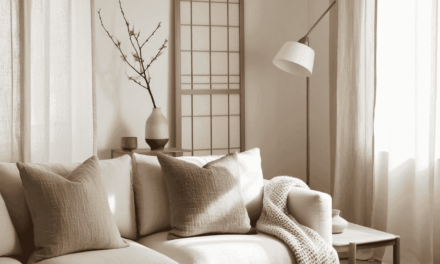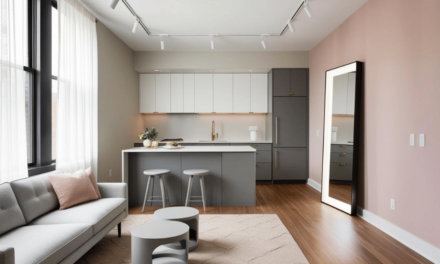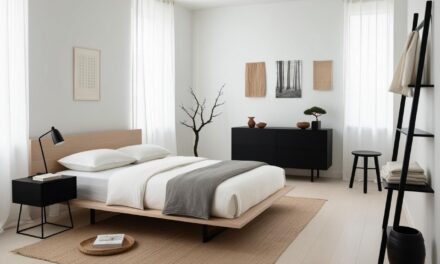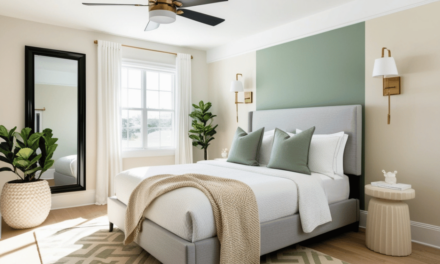Affordable Japandi Decor: Budget-Friendly Tips for the Look
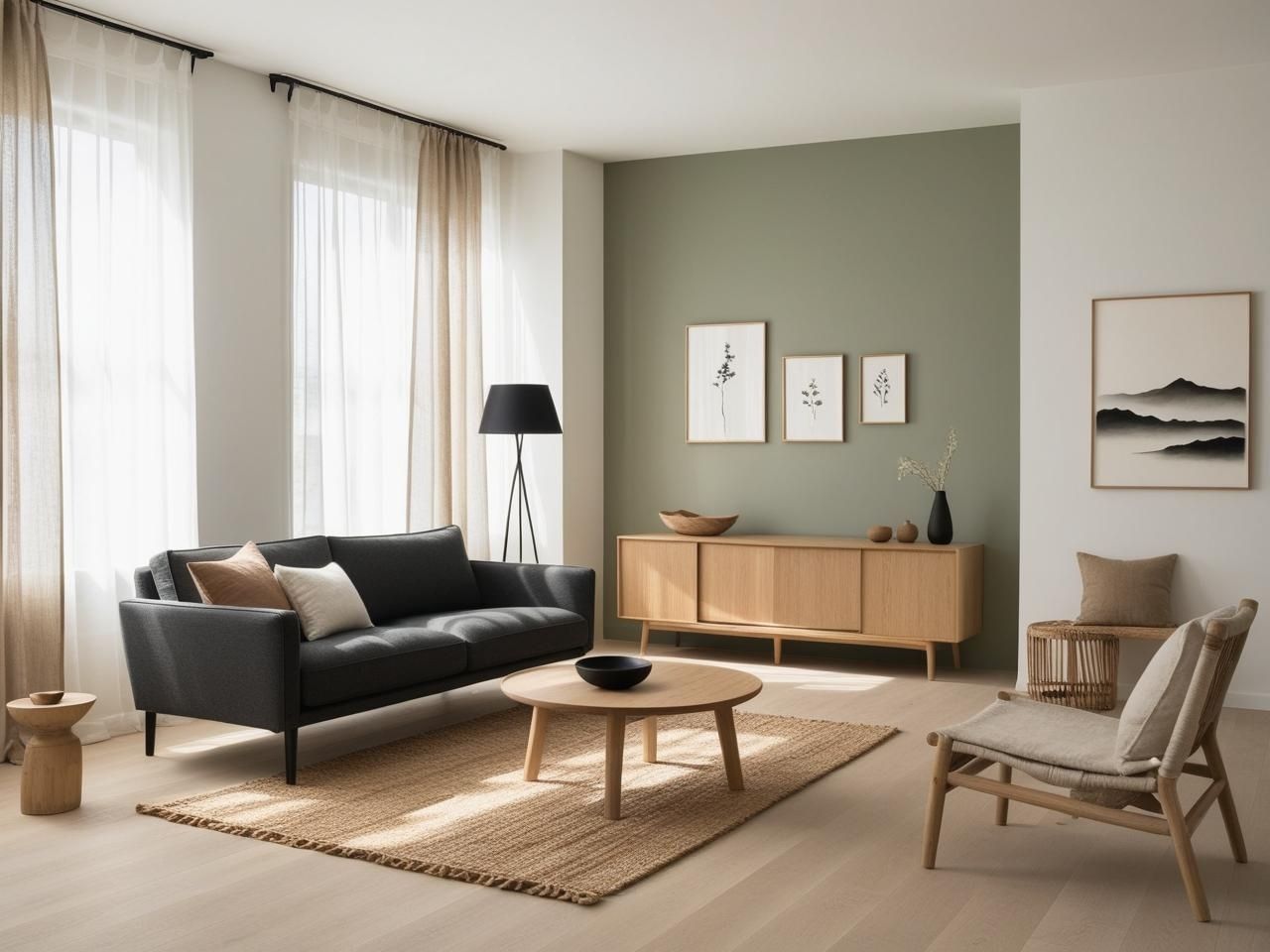
Let’s address the design elephant in the room: you’ve fallen hopelessly in love with Japandi style, but your bank account is giving you serious side-eye every time you browse those impossibly serene Instagram feeds. I get it. Nothing kills a zen moment faster than checking your account balance after buying that “essential” handcrafted wooden bowl that cost more than your weekly grocery budget.
Here’s the delicious plot twist, though: Japandi design is actually one of the few styles that becomes more authentic when you spend less. Yes, you read that correctly. While other design trends practically demand you remortgage your home to keep up, Japandi is essentially whispering, “Please stop buying so much stuff.”
The magical marriage of Japanese minimalism and Scandinavian functionality isn’t about acquiring special, expensive things—it’s about intentionally curating fewer, better things. It’s the design equivalent of Marie Kondo and a sensible financial advisor having a baby that grew up to have impeccable taste.
The secret that those $5,000-per-project designers don’t want you to know? The most authentic Japandi spaces embrace:
- Functional simplicity – Items that serve a purpose rather than just looking pretty on a shelf
- Natural, humble materials – Think bamboo instead of rare exotic woods
- Negative space – Those empty corners aren’t waiting to be filled; they’re intentionally breathing room
- Wabi-sabi imperfection – That secondhand table with character? It’s not damaged; it’s perfectly imperfect
This guide isn’t about finding cheaper versions of expensive things (though we’ll do some of that too). It’s about understanding that true Japandi style costs less by design. It’s a rebellion against the more-is-more mentality that’s been draining bank accounts since the dawn of interior design.
So put away that credit card, take a deep breath, and prepare to create a home that feels both Japanese tea house and Scandinavian cabin—all while your financial advisor nods in relieved approval. Turns out inner peace and financial peace can coexist beautifully in the same stylishly sparse room.
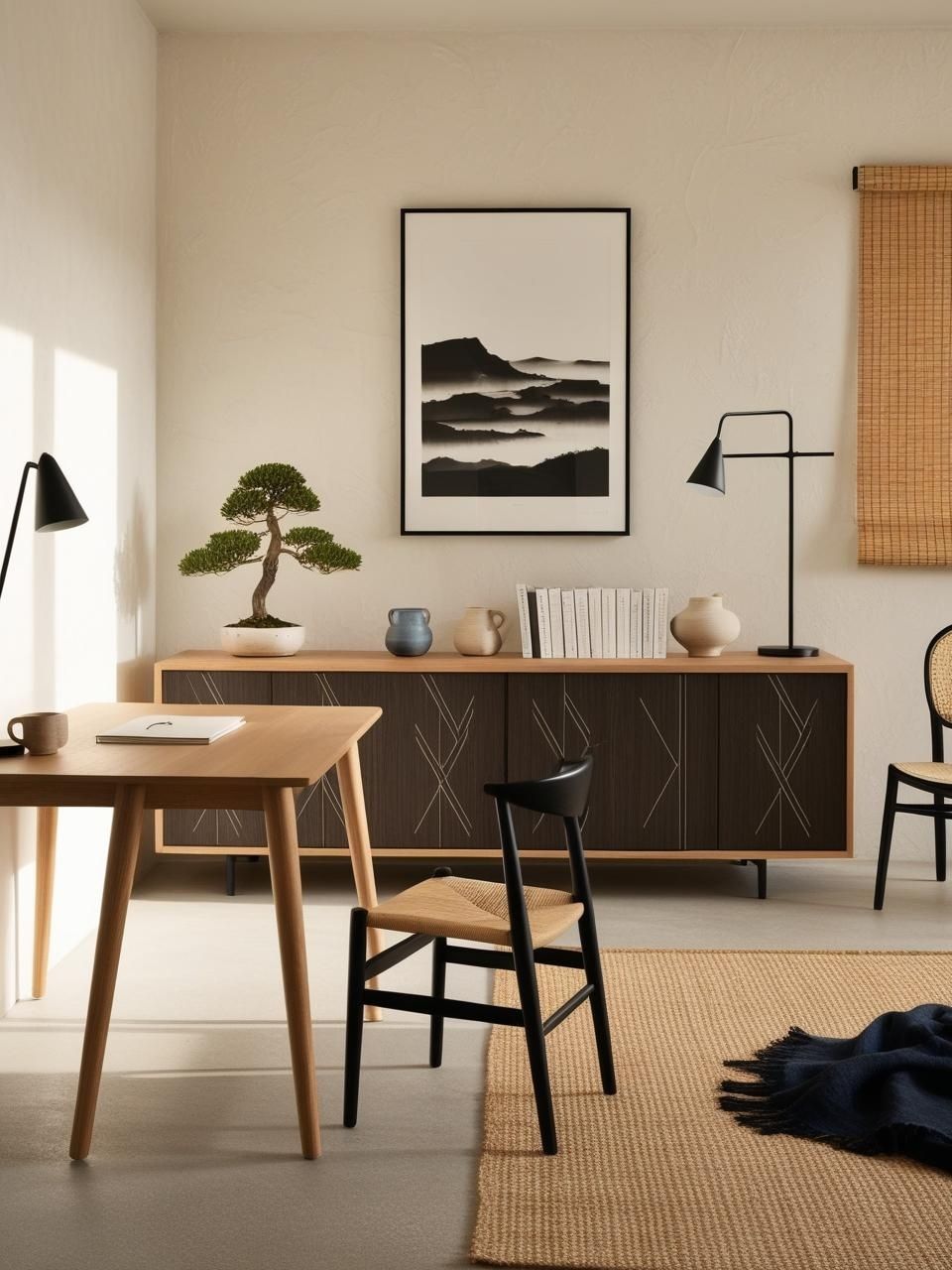
How to Achieve Japandi Style on a Budget
Let’s be honest—most Japandi design features look like they belong in a $5,000-per-night ryokan or a Scandinavian design magazine spread that costs more than your monthly rent. But here’s the delicious secret: authentic Japandi style isn’t about spending obscene amounts of money on perfectly crafted oak furniture. It’s about intention, not your credit card limit.
The Mindset Shift That Saves You Money
Japandi design fundamentally rejects our modern shopping addiction. While the rest of the design world screams “more, more, more,” Japandi whispers “actually, less is fine.” When you’re not trying to fill every corner with stuff, your wallet naturally breathes a sigh of relief.
- Buy once, cry once – Yes, that handcrafted wooden bowl might cost more than the plastic alternative, but you’ll still be using it when those plastic ones are in a landfill three replacements later
- Empty space isn’t a mistake – That bare corner isn’t “unfinished”—it’s intentional breathing room (and a convenient way to save money)
- Quality in the spotlight – When you own fewer things, suddenly that one beautiful ceramic vase becomes the star, not just another voice in a cluttered chorus
The truth about achieving Japandi style without emptying your bank account starts with understanding what you’re actually paying for. Those $300 minimalist wooden shelves? You’re not paying for the wood—you’re paying for someone else’s perfect execution of simplicity. But here’s a radical thought: simplicity itself is free.
Start by clearing rather than adding. Most rooms are suffocating under the weight of too much stuff, none of which can actually shine. Create space first—actual, physical, empty space—and suddenly the affordable pieces you do select have room to make an impact. This isn’t just design philosophy; it’s practical budget advice. When you’re not trying to fill every inch, you can afford to be pickier about the fewer items you do bring home.
Material Matters: The Budget-Friendly Naturals
Japandi thrives on natural materials, but some won’t require a second mortgage:
- Bamboo – Fast-growing, sustainable, and surprisingly affordable for everything from cutting boards to room dividers
- Rattan and jute – These humble fibers create texture without the price tag of more precious materials
- Unfinished woods – Look for unfinished or lightly treated pine and oak pieces that celebrate natural imperfections (what high-end brands call “wabi-sabi” and charge extra for)
- Cotton and linen blends – Pure linen comes with a premium price, but blends deliver that casual-luxe texture for significantly less
The secret to affordable Japandi lies in understanding that “natural” doesn’t automatically mean “expensive.” The design industry has convinced us that anything organic or handcrafted must come with a luxury price tag, but that’s simply not true. Half of what you’re paying for in high-end Japandi pieces is the curated selection someone else has done for you.
Take bamboo, for instance. It’s literally a weed in some parts of the world—the fastest growing plant on earth—yet somehow we’ve been convinced that bamboo cutting boards should cost $75. But venture outside the algorithm-fed design shops, and suddenly you’ll find affordable bamboo everything in Asian markets, discount home stores, and online retailers who haven’t caught the Japandi pricing fever.
The same goes for cotton-linen blends. While pure linen bedding might command premium prices, the reality is that a 60/40 cotton-linen blend often delivers that same relaxed, slightly rumpled texture for half the price. Your sheets don’t need a pedigree to create that effortlessly elegant Japandi bedroom vibe.
The Secondhand Treasure Hunt
The Japandi aesthetic worships craftsmanship and patina—two things that vintage and secondhand pieces have in abundance:
- Facebook Marketplace magic – That mid-century credenza with clean lines? Someone’s practically giving it away because it’s “outdated”
- Thrift store ceramics – Simple stoneware bowls and vases in neutral tones are Japandi gold and often cost less than your morning coffee
- Estate sales – Where solid wood furniture goes to find new homes at fractions of retail prices
- Yard sales – The ultimate treasure hunt for wooden trays, bamboo items, and ceramic pieces that just need a little cleaning to shine
Here’s where budget-friendly Japandi gets really interesting: the style actually benefits from items with history. While other design trends demand factory-fresh perfection, Japandi—with its wabi-sabi appreciation for imperfection—welcomes the gentle wear of a previously loved wooden bench or the slight color variations in secondhand ceramic plates.
There’s a beautiful irony in hunting for Japandi treasures secondhand: the very pieces that high-end retailers are trying to replicate—with their “authentically distressed” finishes and “artisanal imperfections”—are sitting unappreciated at estate sales and thrift stores. That slightly worn edge on a wooden coffee table? That’s not damage—that’s character you’d pay extra for in a showroom.
The key is training your eye to see potential rather than perfection. The slightly faded ceramic vase in the thrift store isn’t sad—it’s subtle. The mid-century side table with clean lines doesn’t need to be labeled “Japandi” to fit perfectly in your space. When you stop shopping for trends and start collecting quality, suddenly your budget stretches twice as far.
The DIY Japandi Secret Weapon
Let’s be real—sometimes the perfect Japandi piece simply doesn’t exist at your price point. That’s when creativity trumps cash:
- Sanding and restaining – That orange-toned oak table becomes Japandi-perfect with sandpaper and a gentle whitewash or matte finish stain
- Simple textile projects – Basic sewing skills turn affordable natural fabric into perfectly sized cushion covers and table runners
- Paper lanterns – Inexpensive paper pendant lights instantly create that soft, diffused Japandi glow without custom lighting prices
What the glossy design magazines won’t tell you is that many showcase Japandi homes feature custom pieces—not because they’re luxury items, but because they’re purpose-built for the space. That $900 minimalist shelf system might seem irreplaceable until you realize it’s essentially just planks and brackets arranged with intention.
The DIY approach to Japandi isn’t about settling—it’s about creating pieces that fit your exact needs rather than forcing generic retail items to work. That wall-mounted oak nightstand floating beside your platform bed? It’s a $15 piece of oak board from the hardware store, sanded smooth and mounted on simple brackets. The perfectly sized bench in your entryway? A basic wooden bench transformed with light sanding and a matte finish.
This isn’t about crafting elaborate furniture from scratch. It’s about simple modifications that transform ordinary items into pieces that look intentional rather than accidental. Even the most basic DIY skills can take you far: sanding rough edges, applying a matte protective finish to raw wood, or simply removing shiny hardware and replacing it with something more subtle.
Color Psychology on a Budget
One of the most overlooked aspects of affordable Japandi design is the power of paint and intentional color choices:
- Whites aren’t created equal – Cool whites create crisp Scandinavian vibes, while warmer whites evoke Japanese tranquility
- Earth tones ground the space – Soft clay, gentle stone, and muted sage create depth without drama
- Black as an accent, not a statement – Strategic touches of black provide anchor points without overwhelming the budget
Paint remains one of the most transformative and budget-friendly tools in design. While trendy Japandi spaces might showcase specialty clay paints and custom plaster finishes, the reality is that a carefully chosen standard paint can deliver 90% of the effect for 20% of the price.
The beauty of Japandi style isn’t in how much you spend—it’s in the thoughtful curation of things that matter. When you’re not trying to fill every inch with stuff, suddenly your budget stretches much further. That’s not just good design—that’s good sense.
Your Shortcut to Effortless Japandi Style
12 refined color palettes & implementation strategies designed to bring warmth, texture, and harmony into your home.
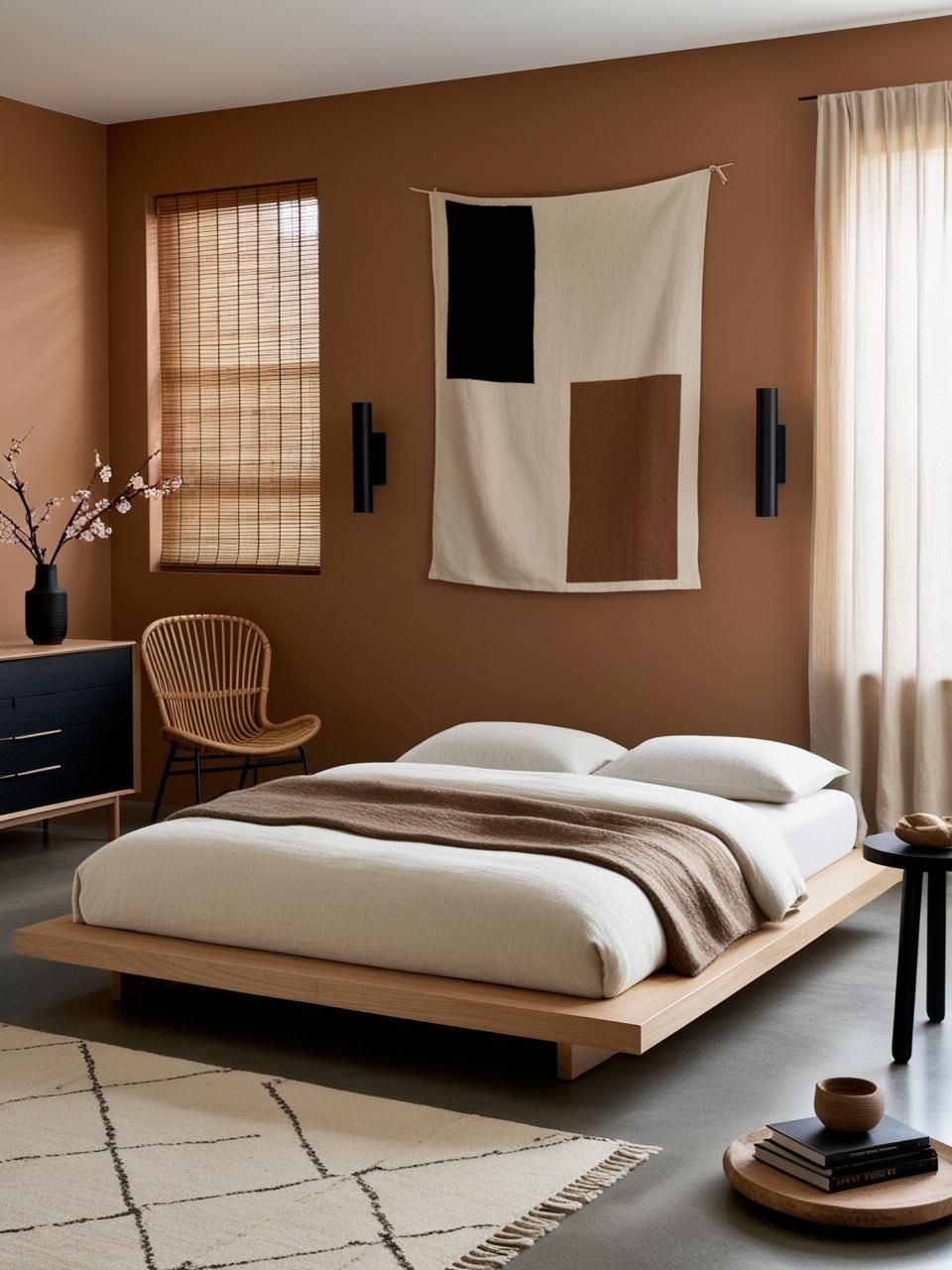
Affordable Japandi Decor Ideas for Every Room
Let’s face it—we’ve all stared longingly at those Japandi interiors on Pinterest with their $3,000 handcrafted oak coffee tables and wondered if we could just eat ramen for six months to afford them. Good news: your taste in design doesn’t have to bankrupt you! Here’s the room-by-room breakdown of achieving that Japandi vibe while your bank account remains on speaking terms with you.
Japandi Living Room Decor on a Budget
The living room—that public-facing space where we all pretend we’re more sophisticated than we actually are. Getting the Japandi look here is about strategic minimalism, not financial masochism.
- The sofa situation: Instead of blowing your budget on that cloud-like linen sectional, look for clean-lined options in natural tones. IKEA’s SÖDERHAMN has been giving expensive designer sofas an identity crisis for years at a quarter of the price.
- Coffee table reality check: That walnut masterpiece with the hefty price tag? Skip it. Hunt for secondhand wooden tables with simple silhouettes—mid-century modern pieces are basically Japandi’s cousins anyway. A little sanding and some matte finish can transform almost anything.
- The texture game: This is where Japandi gets its soul. Layer affordable cotton throws (H&M Home has surprisingly good ones) over that budget-friendly sofa. Add a few linen-blend cushion covers in various neutrals—not perfectly matching, because that’s how actual humans live.
The secret weapon for affordable Japandi living rooms isn’t found in design stores—it’s empty space. That awkward corner you’ve been trying to fill? Leave it gloriously, intentionally empty. Boom—you just saved $300 and accidentally nailed Japandi minimalism.
Japandi Bedroom Decor for Less
Your bedroom doesn’t know you bought everything at a discount, and frankly, neither does anyone else (unless you’re giving tours of your boudoir, in which case, maybe reconsider).
- Platform bed brilliance: If Japandi had a poster child, it would be the low platform bed. IKEA’s MALM or NEIDEN frames give you the look without the luxury markup. Better yet, check Facebook Marketplace for someone else’s abandoned minimalism journey.
- Bedding that doesn’t break you: Pure linen sheets are wonderful but priced like liquid gold. The solution? Cotton-linen blends deliver that casual, slightly rumpled Japandi vibe for half the cost. Or start with just linen pillowcases—they’ll make the most visual impact.
- Lighting logic: Paper lanterns are the unsung heroes of affordable Japandi. For $20-30, these softly glowing orbs transform any bedroom into a serene retreat. They’re practically giving away good design at that price.
The beauty of Japandi bedrooms is their deliberate emptiness. That nightstand with seventeen objects on it? Not Japandi. Try one perfect ceramic mug for water, one book, and maybe—if you’re feeling wild—a small plant. Congratulations, you just mastered Japandi without even trying.
Budget-Friendly Japandi Kitchen & Dining Decor
Kitchens are usually budget-destroyers, but Japandi kitchens actually embrace simplicity—how convenient for our wallets!
- Dishware diplomacy: Step away from those matched 16-piece sets. Japandi loves organic, slightly imperfect ceramics that don’t need to be identical twins. Hit up thrift stores for neutral stoneware, or check H&M Home and Target for their surprisingly good ceramic game.
- The wooden utensil revelation: Bamboo and wooden utensils and cutting boards are both affordable and perfectly Japandi. Asian grocery stores often sell them for a fraction of what West Elm charges.
- Storage with intention: Rather than hiding everything, Japandi kitchens display everyday tools as purposeful objects. That $3 wooden spoon? When arranged thoughtfully on a simple tray, it becomes part of your design story.
Remember, the Japandi kitchen isn’t showing off its latest gadgets—it’s celebrating functional simplicity. That $400 knife set? Maybe unnecessary when two quality knives will handle 99% of your cutting needs. See? Japandi is basically helping you save money.
Japandi Bathroom Decor on a Budget
Bathrooms are small enough that even budget-friendly changes make dramatic impacts. Japandi’s less-is-more approach works wonders here.
- Shower curtain sanity: A simple cotton or linen-look curtain in oatmeal, soft gray, or natural white instantly Japandi-fies your bathroom. No need for patterns or logos or inspirational quotes about bathing.
- Wooden wonderland: A bamboo bath mat costs a fraction of high-end options and brings immediate natural texture. Add wooden accessories like soap dishes and toothbrush holders (often under $15) for cohesion.
- Storage simplified: Instead of plastic organizers, look for simple bamboo trays and small wooden boxes. When your cotton swabs live in a wooden container, they’re suddenly part of your design scheme rather than bathroom clutter.
The Japandi bathroom secret? Everything unnecessary goes away. That collection of half-used products littering your counter? Hidden away or—even better—edited down to just what you actually use. Design magazines would charge you for this advice, but here we are.
Affordable Japandi Home Office Decor
The home office—where we all pretended to be productive during 2020 and have been maintaining the fiction ever since.
- Desk decisions: Skip the expensive designer options and look for simple wooden tables or desks with clean lines. Even a plain slab of wood on affordable legs can look intentionally minimalist rather than desperately bargain-basement.
- Chair considerations: This is where ergonomics and aesthetics need to play nice together. Look for secondhand wooden or bentwood chairs with clean lines, then add a simple cushion for comfort.
- Organization overhaul: Forget plastic organizers. Simple wooden trays, bamboo pen holders, and linen-covered storage boxes tame clutter while maintaining the Japandi aesthetic. The key is consistency in materials—not necessarily matching sets.
The most affordable way to achieve Japandi office vibes is through what you don’t add. That motivational poster with a sunset? The fourteen trinkets from conferences past? The mug that says “Don’t talk to me until I’ve had my coffee”? Japandi gently suggests we reconsider all of these choices.
The Japandi home office isn’t about spending—it’s about creating a space where your mind can actually focus instead of bouncing between seventeen desk toys. When your surroundings are calm, suddenly you might actually finish that report without checking your phone every three minutes. Now that’s a return on investment.
Unlock Designer-Perfect Colors in Minutes
Browse my curated collection of interior color palettes—tailored for today’s most loved design styles.
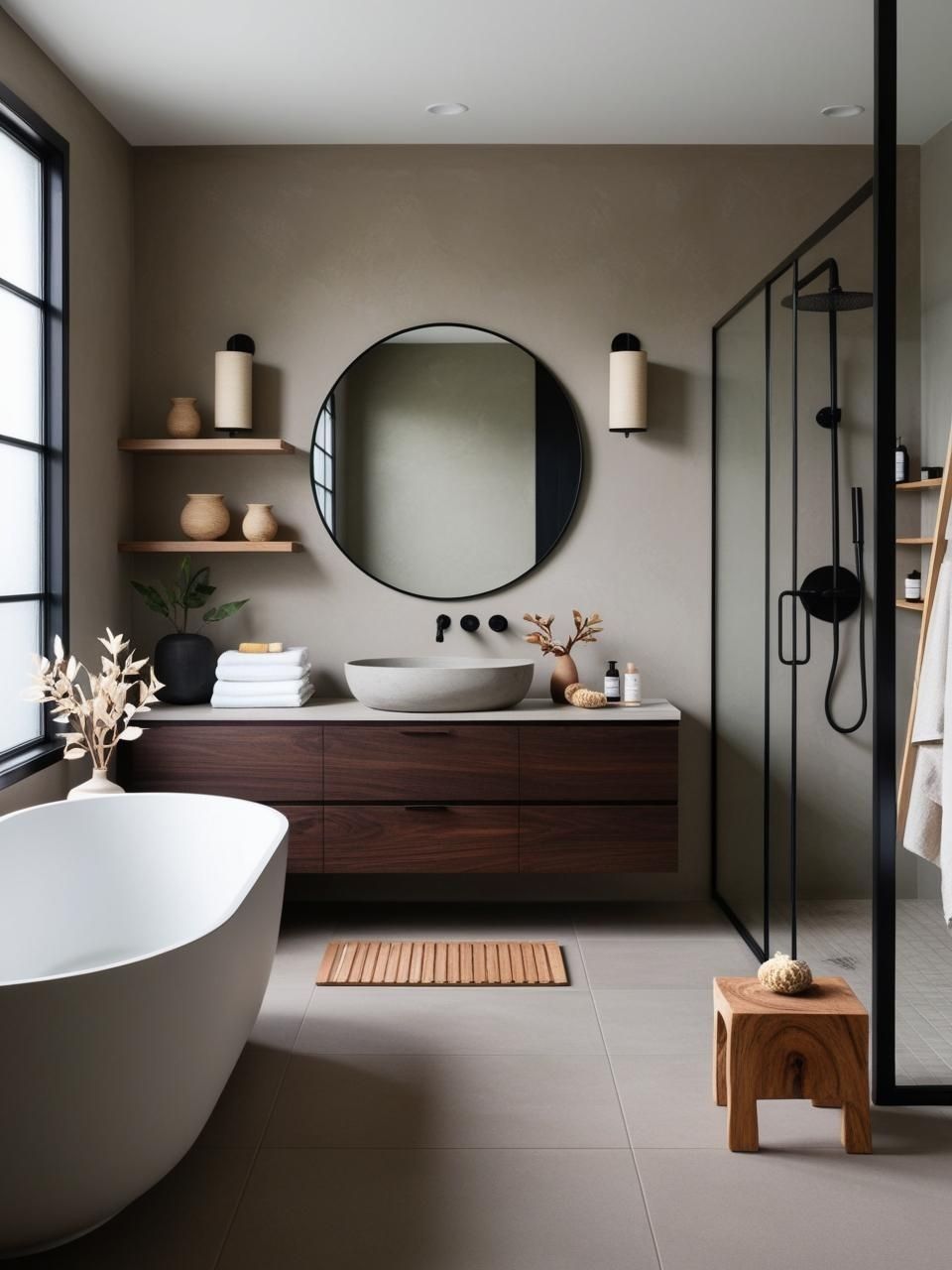
Where to Shop for Affordable Japandi Decor
Let’s address the elephant in the room—you’ve fallen in love with Japandi design, but your wallet is shooting you warning glances every time you browse those curated Japandi Instagram shops where a simple wooden spoon mysteriously costs $85. Fear not, budget-conscious design enthusiasts! The secret to affordable Japandi shopping isn’t knowing where the sales are—it’s knowing where the nonsense markups aren’t.
The IKEA Japandi Goldmine
IKEA deserves a standing ovation for accidentally being Japandi before Japandi was even a thing. Their Swedish minimalism has been flirting with Japanese simplicity for decades.
- The IKEA hack: The BJÖRKSNÄS collection might as well have “Japandi” stamped on it, with its birch construction and clean lines
- Beyond the showroom: Skip the heavily trafficked showroom areas and head to the lesser-known sections where simple wooden bowls and cutting boards live at surprisingly reasonable prices
- Seasonal scores: IKEA’s limited collections often feature rattan, bamboo, and natural textiles that scream Japandi without screaming at your bank account
Here’s the delicious truth about IKEA: while design snobs are busy turning their noses up at it, smart shoppers are mixing selected IKEA pieces with vintage finds for a look that’s indistinguishable from those $50,000 designer Japandi spaces. That IKEA SINNERLIG pendant lamp? It’s basically identical to handcrafted Japanese paper lanterns costing five times as much.
H&M Home: The Undercover Japandi Supplier
The fashion retailer’s home section is the unsung hero of affordable Japandi decor, consistently delivering simple, natural materials without the “curated designer” markup.
- Textile treasures: Their linen-blend cushion covers and throws deliver that perfectly imperfect Japandi texture for a fraction of specialty store prices
- Ceramic surprises: Simple, organic-shaped vases and planters in muted tones regularly appear for under $25
- Seasonal shifts: Their spring collections often feature rattan, bamboo, and other natural materials perfect for Japandi styling
While everyone else is fighting over the last overpriced ceramic vase at that trendy design store, smart shoppers are quietly filling their carts at H&M Home with pieces that look suspiciously similar but cost 70% less. The secret? H&M Home pieces don’t come with elaborate backstories about artisanal craftsmanship—they just look good and function well.
Muji: Japanese Minimalism Without the Markup
Muji is essentially Japanese minimalism in retail form, offering simple, functional items that epitomize the Japandi aesthetic.
- Organization nirvana: Their storage solutions combine form and function without unnecessary flourishes
- Textiles that get it: Their bedding and towels in natural fibers and muted tones fit the Japandi vibe perfectly
- Stationery surprise: Even their simple desk accessories can transform a workspace into a Japandi haven
The beauty of Muji is that it doesn’t try to be precious about minimalism—it just is minimal, by design and by pricing. While other retailers are charging premium prices for “curated Japanese aesthetic,” Muji is actually Japanese and somehow charging less. Make it make sense.
The Secondhand Shopping Strategy
Here’s where the budget-conscious Japandi enthusiast really pulls ahead of the pack: the secondhand market is absolutely drowning in perfect Japandi pieces that nobody recognizes as such.
- Facebook Marketplace reconnaissance: Search terms like “wooden furniture,” “mid-century,” and “minimalist” to find pieces that fit Japandi aesthetic without the Japandi price tag
- Thrift store intelligence: Look for simple ceramic vases, wooden bowls, and rattan baskets that can be Japandi stars with just a little cleaning
- Estate sale gold: These are particularly valuable for finding solid wood furniture with clean lines and quality construction
There’s a beautiful irony in the fact that many people are discarding exactly what others are paying premium prices for. That “outdated” teak sideboard someone’s practically giving away? It’s practically identical to the “contemporary Japandi credenza” selling for $2,400 in design showrooms.
The Online Budget Japandi Circuit
Beyond the obvious retail suspects, several online retailers consistently deliver Japandi-friendly pieces without the luxury markup.
- Wayfair’s wooden wonders: Filter for natural materials and clean lines to find surprisingly affordable Japandi-compatible furniture
- Overstock’s hidden gems: Their warehouse model often means discounted prices on simple wooden furniture that fits the Japandi aesthetic
- Etsy’s artisanal advantage: Small makers often offer handcrafted ceramics and wooden items at prices below big-name design stores
The key to online Japandi shopping is ignoring how things are marketed and focusing on materials and silhouettes. That “Bohemian rattan chair” could easily be your new “Japandi accent piece” with the right styling—and at half the price of the identical chair being marketed as Japandi.
The Asian Grocery Store Secret
Here’s a truly insider tip: Asian grocery stores often have housewares sections that are Japandi goldmines.
- Bamboo bonanza: Everything from steamers (which make perfect storage containers) to utensils at prices that would make West Elm weep
- Ceramic scores: Simple, functional dishware without designer markups
- Rice paper lamps: Often available for a fraction of what design stores charge
The irony is delicious—while design influencers are paying premium prices for “Japanese-inspired” items, you can buy actually Japanese items at the local Asian grocery for a quarter of the price. The difference? One comes with a curated Instagram aesthetic, the other just comes with authenticity.
The truth about Japandi shopping is refreshingly simple: the style itself celebrates humble materials and functional design, which means you don’t need specialty stores or designer names to achieve it. The real skill isn’t in knowing where to splurge—it’s in recognizing quality and simplicity regardless of where you find it or what the price tag says.

DIY Japandi Decor Ideas to Save Money
Let’s address the beautifully crafted elephant in the room—your champagne Japandi taste is arm-wrestling with your beer budget, and your budget is currently winning. Before you resort to selling a kidney for that handcrafted walnut coffee table, let me introduce you to the magical world of DIY Japandi, where “handcrafted” can mean “by your hands” and not some bearded artisan who charges $300 an hour.
Clay Play: Wabi-Sabi Without the Sob Story Price Tag
Those perfectly imperfect ceramic pieces that cost more than your monthly car payment? Turns out clay is still just… earth. And it’s remarkably affordable.
- Air-dry clay magic: For $10-15, you can grab enough air-dry clay to create several organic-shaped vessels that scream “I paid too much for these” when in reality, you made them while binge-watching that show you’re slightly embarrassed to admit you love
- The pinch pot renaissance: The technique you learned in third grade is suddenly high design—simple pinch pots with organic edges make perfect catch-alls for keys, jewelry, or your dignity after you realize you almost spent $95 on something similar
- Textural adventures: Press textured fabric, rice, or even mesh bags into clay for subtle patterns that look intentional rather than “I had no idea what I was doing”
The beauty of DIY ceramics is that Japandi actually celebrates imperfection. That wobbly edge? It’s wabi-sabi, darling. That slightly lopsided bowl? Perfectly imperfect. Meanwhile, high-end retailers are literally manufacturing these “authentic imperfections” and charging you a premium for them. The irony could fill a very expensive, slightly asymmetrical Japandi vase.
Furniture Resurrection: From Drab to Fab Without the Cashectomy
That particle board nightmare lurking in your spare room or the suspiciously orange oak table your aunt bequeathed you? They’re just Japandi pieces in witness protection.
- The power of sandpaper: Nothing transforms dated wood furniture faster than stripping away those 1990s orange/yellow finishes to reveal the quieter, more natural wood beneath
- Whitewash wizardry: A subtle whitewash (1 part white paint, 2 parts water) creates that sun-bleached Scandinavian vibe that would cost you $1,200 in a showroom
- Matte finish miracle: Simply replacing a glossy finish with a matte one can transform a piece from “suburban office park” to “Kyoto retreat”
Here’s the scandalous truth: many high-end Japandi furniture pieces are literally just oak, maple, or pine with simpler lines and different finishes than their more ornate cousins. That $2,400 Japandi sideboard? It’s giving your aunt’s buffet serious side-eye because they share the same bones—one just got a better makeover.
Textile Transformations: No-Sew Doesn’t Mean No-Way
Textiles are the unsung heroes of Japandi design, and they’re also some of the easiest DIY projects for the crafting-challenged among us.
- Drop cloth drama: $15 worth of painter’s drop cloth can become perfectly textured throw pillow covers, table runners, or even curtains with some strategic cutting and hemming tape
- Shibori for dummies: Basic indigo dye kits let you create authentic Japanese-inspired textiles through a fold-and-dye technique that’s basically just sophisticated tie-dye
- Fringe benefits: Adding simple fringe to plain cotton or linen textiles creates instant texture and visual interest without requiring advanced crafting skills
The thing about textiles is that once they’re draped artfully over your sofa or bed, nobody’s examining the stitching with a magnifying glass. That slightly wobbly hemline on your DIY linen throw pillows? It’s a design feature showing the human touch, not a crafting fail. At least that’s what you can tell your judgmental mother-in-law.
Wall Art That Doesn’t Require a Second Mortgage
Nothing completes Japandi spaces like simple, nature-inspired wall art—which, fortunately, doesn’t require formal art training to create.
- Ink wash simplicity: Black ink on rice paper or watercolor paper creates strikingly simple motifs that look far more sophisticated than the five minutes they took to make
- Pressed botanicals: Gather interesting leaves or grasses, press them, and frame them in simple wooden frames for instant Japandi-approved wall art
- Abstract minimalism: Simple brush strokes in neutral tones on canvas can create abstract pieces that galleries would charge four figures for
The secret art world truth: much of minimalist art is actually quite accessible to create. Those simple ink drawings of a single branch? You don’t need an MFA to make something similar. Those abstract neutral canvases? They’re often just layers of slightly different beige tones. I’m not suggesting you could be the next great minimalist artist, but for wall décor purposes? You’ve got this.
Lighting Transformations: From Blah to Spa
Lighting might seem like a technical challenge, but some of the most iconic Japandi lighting fixtures are surprisingly DIY-friendly.
- Paper lantern revival: $10 paper lanterns instantly create that soft, diffused light that makes everyone look like they’ve had exactly the right amount of sleep
- Bamboo pendant makeovers: Plain pendant light kits combined with bamboo trivets or small baskets create sculptural fixtures that look designer but cost drive-thru money
- Branch suspension: Driftwood or interesting branches suspended horizontally with simple pendant bulbs hanging down create natural chandeliers with major design impact
Lighting is the ultimate mood-setter in Japandi spaces, and fortunately, it’s also where simple DIYs can make dramatic differences. That branch with pendant lights? It’s either “overpriced designer lighting concept” or “thing I found in the woods and put lights on,” depending entirely on your storytelling skills and confidence level.
The Secret Formula: Intention + Natural Materials = Japandi Magic
The throughline in all these DIYs isn’t craftiness—it’s intentionality. Japandi design celebrates:
- Natural over synthetic: Materials that come from the earth rather than a laboratory
- Function over decoration: Items that serve a purpose rather than just taking up space
- Simplicity over complexity: Clean lines and forms rather than ornate details
When your DIY projects honor these principles, they automatically align with Japandi aesthetics, regardless of your crafting pedigree. That simple wooden tray you stained a softer tone? It’s not “just a DIY project”—it’s a mindful creation that celebrates natural materials and functional simplicity.
The most liberating truth about DIY Japandi is that the style itself celebrates imperfection, simplicity, and natural variations. In other words, it’s the most forgiving design style for non-professional creators. Your slightly wobbly ceramic vase isn’t a failure—it’s authentically wabi-sabi. Your not-quite-straight hemline on that linen pillow cover? A celebration of the human touch in an increasingly machine-perfect world.
Now go forth and create with confidence, knowing that your budget constraints aren’t limiting your style—they’re actually pushing you toward the authentic heart of Japandi design.
Your Shortcut to Effortless Organic Modern Style
12 refined color palettes designed to bring warmth, texture, and harmony into your home.
Tips for Keeping Japandi Decor Budget-Friendly
Let’s talk about the fact that Japandi isn’t about having figurines of every animal in the zoo scattered across your surfaces. The truth? Japandi style is basically begging you to spend less money. It’s practically a financial intervention with better lighting.
Multi-Functional Furniture: The Japandi Money-Saving Superstar
The dirty little secret of budget-friendly Japandi living is that multi-functional pieces aren’t just practical—they’re basically required reading for the aesthetic.
- Storage that doesn’t look like storage: That low wooden bench in your entryway? It should be hiding your shoes. That elegant wooden chest? It’s where your ungodly collection of charging cables lives now.
- The platform bed revelation: Those gorgeous Japandi platform beds aren’t just fashion statements—they’re storage champions in disguise. Drawers underneath mean you can skip the dresser entirely. One piece, two functions, half the budget damage.
- Coffee tables with hidden depths: Look for simple wooden designs with drawers or lifting tops. Your remote collection needs a home that isn’t “scattered across every visible surface.”
Here’s the financial enlightenment moment: when one piece does the job of two, you’ve just cut your furniture budget in half. Revolutionary, I know. Plus, fewer pieces mean your space looks intentionally minimal rather than “I can’t afford furniture.” Win-win.
The Timeless Color Strategy: Neutrals Are Your Financial Friend
The Japandi color palette isn’t just aesthetically calming—it’s financially strategic. Trendy colors are the serial daters of the design world: exciting at first, exhausting after three months.
- The beige brigade: Those soft, natural tones aren’t just soothing—they’re timeless. That mustard yellow accent wall? It’ll be haunting you by next season, demanding a repaint and reopening your wallet.
- White isn’t just white: Creamy, warm whites create that cozy Japandi atmosphere without constantly whispering “repaint me” as trends change. They’re like the financial advisors of your color scheme—stable, reliable, and quietly saving you money.
- Nature’s palette never expires: Those soft greens, gentle blues, and earthy terracottas pulled straight from nature? They were in style when your grandparents were dating, and they’ll still be sophisticated when your grandkids are redecorating. That’s generational financial wisdom.
The brutal truth about color trends is that they’re designed to make you redecorate regularly. Japandi’s commitment to natural, timeless tones isn’t just zen—it’s financial self-defense against the design industry’s planned obsolescence.
The High-Low Mix: Strategic Splurging for Maximum Impact
Contrary to what your Instagram feed suggests, you don’t need to remortgage your home to achieve Japandi style. The secret is knowing where to splurge and where to save without anyone being the wiser.
- The statement piece strategy: Invest in ONE piece that anchors the room—maybe that wooden coffee table or platform bed frame—and go budget-friendly on everything around it. It’s like wearing a designer jacket with Target jeans. Nobody’s checking the labels on your side tables.
- The touch test principle: Spend where you feel—splurge on that linen throw blanket or wool cushion cover that you actually touch every day. Save on the decorative bowl that nobody’s fondling regularly.
- The eye-level rule: Your investment pieces should sit at eye level where they’re most noticed. That handcrafted ceramic vase on the mantel? Worth it. The equally expensive one hidden on a bottom shelf? Financial malpractice.
This isn’t about being cheap—it’s about being smart. Even those drool-worthy Japandi interiors in design magazines use this trick. The photographer just conveniently crops out the IKEA floor lamp lurking in the corner next to the $3,000 handcrafted chair.
The Secondhand Swagger: Wabi-Sabi Means Pre-Loved is Perfect
Let’s set the record straight—wabi-sabi, the Japanese concept of finding beauty in imperfection, is basically a philosophical justification for buying used stuff. And it’s brilliant.
- The patina privilege: That slight wear on a wooden dining table? In Japandi, that’s not damage—that’s character development. The slight fading on that ceramic vase? We call that “depth” now.
- The history bonus: Secondhand pieces come with stories built in. That bench with the minor scratch? It’s not flawed—it’s “storied.” Try getting that from a factory-fresh reproduction at triple the price.
- The budget-to-style ratio: The most shocking truth in design is that often, the most expensive new items are trying to look like they’ve been loved for decades. Meanwhile, actual decades-old items are sitting in thrift stores at 10% of the price.
The ultimate Japandi power move is pointing to your Facebook Marketplace find and casually mentioning how you “appreciate the authentic aging process and natural patina development.” Translation: “I paid $40 for this and saved $460.”
The Minimalist Reality Check: Less Stuff Equals Less Spending
The most radical budget strategy in Japandi design isn’t finding deals—it’s embracing emptiness. Revolutionary concept, I know.
- The empty corner acceptance: That awkward corner you’ve been trying to fill with something, anything? Leave it gloriously, intentionally empty. Congratulations, you just saved whatever you were about to waste on a unnecessary accent piece.
- The decor diet: Japandi spaces typically have about 60% less “stuff” than other design styles. That’s not just aesthetic—that’s mathematical savings.
- The buying pause: Before adding anything new, ask yourself the Japandi question: “Does this serve a purpose or bring beauty in an essential way?” If the answer isn’t a hell-yes, it’s a no. Your wallet just sighed with relief.
This isn’t deprivation—it’s liberation. Every item not purchased is money saved, space reclaimed, and dusting avoided. Japandi isn’t just a design style; it’s a financial wellness program disguised as attractive interiors.
The Final Reckoning: Quality Over Quantity Always Wins
The ultimate Japandi budget wisdom isn’t about finding the cheapest version of everything—it’s about redefining what “enough” looks like.
- The capsule home concept: Just as capsule wardrobes revolutionized closets, the Japandi approach creates a “capsule home”—fewer, better pieces that work harmoniously together.
- The maintenance math: One well-made wooden chair will outlast five cheap ones, while looking better throughout its lifetime. That’s not just design sense—that’s financial sense.
- The happiness equation: Studies repeatedly show that experiences bring more lasting happiness than accumulating stuff. Japandi’s focus on creating peaceful, functional spaces rather than showcasing possessions isn’t just stylish—it’s scientifically sound life advice.
The radical truth at the heart of budget-friendly Japandi is that it asks us to want less rather than find cheaper ways to have more. In a consumerist culture perpetually shouting “more, more, more,” that’s not just design rebellion—it’s financial revolution.
And honestly? Your bank account could probably use a little revolution right about now.
Curated Wall Art for Elegant Homes
Bring softness, texture, and intention into your home with digital wall art inspired by wabi-sabi, abstract forms, and muted watercolors. Every piece is crafted to create stillness and beauty—whether you’re styling a gallery wall or a minimalist nook.
Conclusion
Creating a Japandi home isn’t about having unlimited funds—it’s about having unlimited intention. The style itself is practically begging you to buy less, choose better, and enjoy more empty space (both in your rooms and your credit card statement).
The most satisfying revelation about budget-friendly Japandi isn’t finding cheaper versions of expensive things—it’s realizing that the most authentic version of this style actually costs less by design. That wooden tray holding your morning coffee isn’t just a tray—it’s a daily reminder that simplicity isn’t a compromise; it’s the whole point.
So go forth with your second-hand wooden bench, your DIY ceramic bowls, and your purposefully empty corners. Your bank account is breathing a sigh of relief, and somewhere in both Kyoto and Copenhagen, design ancestors are nodding in approval. Not of your savings (though those are impressive), but of your growing understanding that true Japandi style was never about what you buy—it’s about what you don’t.

